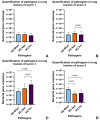Health-Economic Impact Attributable to Occurrence of Pleurisy and Pneumonia Lesions in Finishing Pigs
- PMID: 39729008
- PMCID: PMC11680166
- DOI: 10.3390/vetsci11120668
Health-Economic Impact Attributable to Occurrence of Pleurisy and Pneumonia Lesions in Finishing Pigs
Abstract
Respiratory diseases, such as pleurisy and pneumonia, cause significant health and economic losses in pig production. This study evaluated 867 finishing pigs from a farm with a history of respiratory issues, using macroscopic lesion scoring (SPES and CVPC), histopathological analysis, qPCR diagnostics, and economic modeling. Severe pleurisy (scores 3 and 4) was observed in 42.1% of carcasses and was strongly correlated with higher bacterial loads of Mycoplasma hyopneumoniae, Actinobacillus pleuropneumoniae, and Pasteurella multocida. Severe lesions reduced the average daily gain (ADG) and carcass weight, leading to increased production costs and lower profitability. Economic analysis revealed that pigs with higher pleurisy scores incurred an additional cost per kg (USD 1.29 vs. USD 1.32 for milder cases), reduced total revenue by 1.36%, and decreased return on investment (ROI) from 5.33% to 3.90%. These findings emphasize the critical impact of respiratory diseases on profitability and the necessity of robust health management strategies, including vaccination and enhanced biosecurity, to minimize economic losses in swine farming.
Keywords: ADG; Actinobacillus pleuropneumoniae; Mycoplasma hyopneumoniae; PRDC; Pasteurella multocida; SPES; intensive pig farming.
Conflict of interest statement
Author Flávio Hirose was employed by the company Ourofino Animal Health. The remaining authors declare that the research was conducted in the absence of any commercial or financial relationships that could be construed as a potential conflict of interest.
Figures



Similar articles
-
Associations between Pleurisy and the Main Bacterial Pathogens of the Porcine Respiratory Diseases Complex (PRDC).Animals (Basel). 2023 Apr 27;13(9):1493. doi: 10.3390/ani13091493. Animals (Basel). 2023. PMID: 37174529 Free PMC article.
-
Impact of porcine respiratory disease complex on carcass weight and meatiness: quantitative insights from a mixed-model analysis.BMC Vet Res. 2024 Dec 6;20(1):554. doi: 10.1186/s12917-024-04410-3. BMC Vet Res. 2024. PMID: 39643874 Free PMC article.
-
Serological patterns of Actinobacillus pleuropneumoniae, Mycoplasma hyopneumoniae, Pasteurella multocida and Streptococcus suis in pig herds affected by pleuritis.Acta Vet Scand. 2016 Oct 4;58(1):71. doi: 10.1186/s13028-016-0252-1. Acta Vet Scand. 2016. PMID: 27716292 Free PMC article.
-
Review on the methodology to assess respiratory tract lesions in pigs and their production impact.Vet Res. 2023 Feb 1;54(1):8. doi: 10.1186/s13567-023-01136-2. Vet Res. 2023. PMID: 36726112 Free PMC article. Review.
-
Mycoplasma hyopneumoniae: interaction with other agents in pigs, and evaluation of immunogens.Arch Med Res. 1994 Summer;25(2):235-9. Arch Med Res. 1994. PMID: 7919820 Review.
Cited by
-
Use of Subtherapeutic Tylvalosin Against Mycoplasma hyopneumoniae: Implications For Respiratory Microbiome Dysbiosis and Swine Lung Health.Transbound Emerg Dis. 2025 Aug 18;2025:8903237. doi: 10.1155/tbed/8903237. eCollection 2025. Transbound Emerg Dis. 2025. PMID: 40861113 Free PMC article.
-
Evaluating the Immunogenic Potential of ApxI and ApxII from Actinobacillus pleuropneumoniae: An Immunoinformatics-Driven Study on mRNA Candidates.Vet Sci. 2025 Apr 27;12(5):414. doi: 10.3390/vetsci12050414. Vet Sci. 2025. PMID: 40431507 Free PMC article.
References
-
- Pessoa J., Rodrigues da Costa M., García Manzanilla E., Norton T., McAloon C., Boyle L. Managing respiratory disease in finisher pigs: Combining quantitative assessments of clinical signs and the prevalence of lung lesions at slaughter. Prev. Vet. Med. 2021;186:105208. doi: 10.1016/j.prevetmed.2020.105208. - DOI - PubMed
LinkOut - more resources
Full Text Sources

